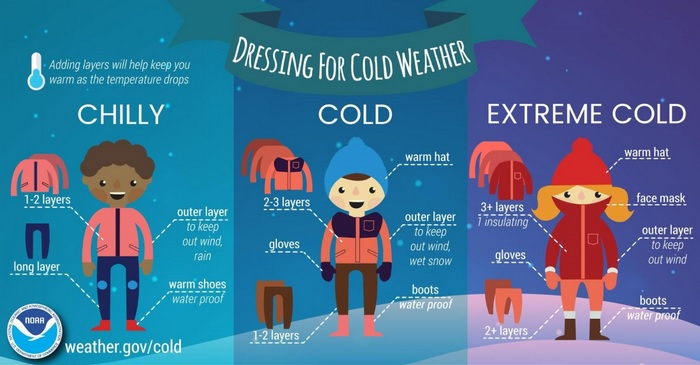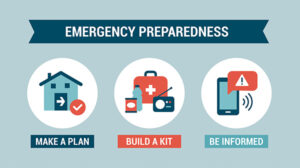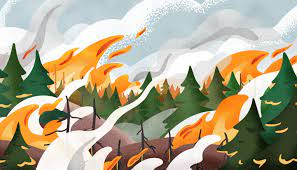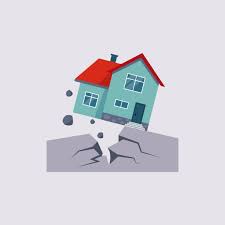Resources
Emergency Resources
Emergency Preparedness Resources. Please click into each section for additional information on various potential disasters in our area and what you can do today to prepare yourself.
Current Incidents & Events:
No current incidents or events to report at this time.
Winter Weather
Winter weather brings with it a multitude of different challenges and concerns for safety. In addition to preparing for extreme cold with the information provided below, you will also find information in the links to Public Safety Power Shutoff, Flood, and General Emergency Preparedness very useful to be prepared for winter related emergencies. What constitutes extreme cold and its effects can vary across different areas of the country. In regions relatively unaccustomed to winter weather, near freezing temperatures are considered “extreme cold.” Whenever temperatures drop decidedly below normal and as wind speed increases, heat can leave your body more rapidly. Exposure to cold temperatures, whether indoors or outside, can cause other serious or life-threatening health problems and anyone can be affected. To keep yourself and your family safe, you should know the early warning signs of hypothermia and what to do to prevent cold-weather health emergencies.

Hypothermia occurs when more heat escapes from your body than your body can produce. Hypothermia usually occurs gradually. Often, people aren’t aware that they need help, much less medical attention. Signs and symptoms of hypothermia may include:
- the “-umbles“: Stumbles, Mumbles, Fumbles, Grumbles and/or slurred speech
- gradual loss of mental and physical abilities
- shivering, which is your body’s attempt to generate heat through muscle activity
- abnormally slow rate of breathing and cold, pale skin
- unusual or extreme fatigue, lethargy or apathy.
Persons exhibiting these symptoms need medical attention immediately.
Understand Wind Chill
The Wind Chill index is the temperature your body feels when the air temperature is combined with the wind speed. It is based on the rate of heat loss from exposed skin caused by the effects of wind and cold.

Dressing warmly when it is very cold out is dressing for success. Be sure the outer layer of your clothing is tightly woven, preferably wind resistant, to reduce body-heat loss caused by wind. Wool, silk, or polypropylene inner layers of clothing will hold more body heat than cotton. Stay dry— wet clothing chills the body rapidly. Excess perspiration will increase heat loss, so remove extra layers of clothing whenever you feel too warm.

Additional Resources:
https://www.ready.gov/winter-weather
General Emergency Preparedness

Take these 3 easy steps to prepare you, your family, your household, and those around you for a possible disaster situation.
- Make a Plan
- Create a plan on how you will evacuate your house and where you will meet up once you have evacuated
- Create a list of emergency contact numbers and names for:
- Someone who lives close by (such as a neighbor or apartment manager)
- Family or friends
- Other important contact
- Support Staff
- Regional Center Service Coordinator
- Build a Kit:
- Make a personalized emergency kit with resources specific to your needs.
- Basic Needs Are:
- Water
- Food (Shelf Stable Food)
- Extra Clothes (including a coat)
- Gloves
- Service Animal Supplies
- Basic First Aid
- Your Required Medications
- Whistle
- Garbage Bags
- Battery Operated or Hand-Crank Radio
- Battery Operated or Hand-Crank Flashlight
- Extra Batteries
- Cash
- Keep a copy of your Insurance & ID Card(s), important documents and emergency plan with emergency contact numbers sealed in a plastic bag.
- Basic Needs Are:
- Make a personalized emergency kit with resources specific to your needs.
- Be informed
- Emergency Notification System by County
- Santa Clara County – Alert SCC is the official emergency alert and warning system for Santa Clara County. This tool will help you get the most up-to-date information on emergencies and disasters happening in your area.
- Monterey County – Nixle and Alert Monterey County are two great resources to provide alert and warnings via email or text message.
- Santa Cruz & San Benito County – Code Red is the Emergency Notification system used by Santa Cruz and San Benito County 9-1-1 to send out important messages to the community.
- Radio Stations to tune into
- Santa Clara County:
- KSJO 92.3 FM
- KFRC 106.9 FM or 740 AM
- KSJX 1500 AM (Vietnamese)
- KSOL 98.9/99.1 FM (Spanish)
- KSQQ 96.1 FM (Chinese)
- Santa Cruz County:
- KSCO 1080 AM
- KTOM 92.7 FM
- Monterey County:
- KPIG 107.5 FM
- San Benito County:
- KTOM 92.7 FM
- Santa Clara County:
- Know your evacuation zone.
- Santa Clara County – check out Santa Clara County Fire Departments resource page to locate your evacuation zone.
- Santa Cruz County – Santa Cruz County has created this page to find your evacuation zone.
- San Benito County – San Benito County will provide updates on evacuations and hazard specific information on their county website.
- Monterey County – Monterey County will provide updates on their website for evacuations and other hazard-specific information.
- Cell Phone Applications for additional information
- Wildfire Monitoring - Watch Duty App allows you to stay up to date on wildfires in your area. Watch Duty will keep you updated on information from Cal Fire and fire spotters for things like evacuations, containment of spread and so much more.
- Rescu App – set up the Rescu Application to help First Responders in assisting you by storing information and calling for assistance with two clicks of a button while notifying your emergency contacts at the same time.
- American Red Cross – The American Red Cross has many apps that are disaster specific, such as an Emergency App and Earthquake App, along with apps for how to do basic first aid and so much more.
- FEMA Mobile App – FEMA has created a free phone application to help you receive real-time weather alerts, locate local emergency shelters in your area and much more.
- Emergency Notification System by County
Heat Wave

Heat Waves occur when we experience very high temperatures during the day with higher-than-normal temperatures in the evening or overnight. Heat Waves typically happen over the summer months. It is important that you prepare yourself, those around you and your home for a potential heat wave.
Things to do to help you stay healthy and safe during a heat wave:
- Drink plenty of water – even before you are thirsty (avoid sugary beverages and caffeine drinks.
- Limit physical activity during peak heat hours between 10am-3pm – opt for morning or evening hours instead.
- Never leave people of any age, pets, medications, or food in a closed, parked car.
- Stay in an air-conditioned area whenever possible.
- Wear cool clothing – lightweight, light-colored, and loose-fitting clothing are recommended to help keep you cool.
- Wear sunscreen and sunglasses when outside
- Cover your head – wear a wide-brimmed, vented hat or use an umbrella as your heat absorbs heat easily.
Below are resources to help during a heat wave:
- Emergency Cooling Shelters – free places in your community to wait out the hottest part of the day.
- PG&E Tips & Resources for staying cool, saving energy, and creating an emergency plan for staying cool.
- California Office of Emergency Services – Flex Alert Information and Tips for Staying Cool
- Check to see if your residence is the target of a rotating power outage with PG&E.
Wildfire

Wildfire season is between May and November; however, a wildfire can occur at any time. Make sure you and your family are prepared.
Tips for wildfire evacuation:
- Shut all windows and doors, leaving them unlocked.
- Remove flammable window shades, curtains, and close metal shutters.
- Move flammable furniture to the center of the room, away from windows and doors.
- Shut off the gas at the meter; turn off the pilot light.
- Leave your lights on so firefighters can see your house under smoky conditions.
- Shut off the air conditioning.
- Gather up flammable items from the exterior of the house and bring them inside.
- Turn off propane tanks.
- Move propane BBQ appliances away from structures.
- Connect garden houses to outside water valves or spigots for use by firefighters.
- Don’t leave sprinklers or water running, they can affect critical water pressure.
- Leave exterior lights on so your home is visible to firefighters in the smoke or darkness of night.
- Put your Emergency Supply Kit in your vehicle.
- Back your car into the driveway with the vehicle loaded and all doors and windows closed. Carry your car keys with you.
Resources:
- CalFire has created guidance on how to prepare your home and surroundings for a potential wildfire.
- CalFire has created resources for when an evacuation order has been issued.
- USDA have created a fire evacuation check-list to help individuals prepare at home for a wildfire.
Public Safety Power Shutoff (PSPS)/Power Outages

Public Safety Power Shut-Offs, also known as PSPS events, are planned power outages run by the power company (in our case, PG&E) to help reduce the possibility of a power related disaster – such as a wildfire. With PSPS events, comes the loss of power that many need to survive.
Losing power can be frustrating and an unwelcome disruption to your life; PG&E has created preparation tips to keep you safe and your life as normal as possible during the PSPS event.
- Make sure you have food that is safe to eat.
- Make ice ahead of time to store up and keep your refrigerator food cold, and freezer foods at optimal temperature while the power is off.
- Make sure to limit the number of times you open your refrigerator and freezer doors to ensure that your food stays colder longer.
- Make sure you have food that you can eat that does not require a power source to make the food consumable.
- Make sure you have a plan for items in your house that may require a power source.
- Make sure you have a back-up key or extra battery pack for locks and other electronics that require power to run.
- Ensure you have a radio with a battery or crank that can provide critical updates as needed to ensure you stay up to date.
- Make a plan about where you can get free WIFI should you need access to the internet.
Resources:
- California Foundation for Independent Living Centers and Disability Disaster Access have partnered together to provide free portable battery back-ups for individuals using medical devices. To sign-up for these resources, please fill out Disability Disaster Access & Resource Application here.
- Medical Baseline Program – hosted by PG&E, is an assistance program that provides 2 kinds of assistance to residential customers that depend on power for medical needs. The assistance if in the form of an additional monthly allotment of energy at the lowest price at your current rate, and extra notifications in advance of public safety power shutoffs. Check out PG&E’s website to find out if you are eligible.
- FEMA has created guidelines and suggestions on how to prepare for a possible power outage. Look at the recommendations for alternative power sources, appliances, food storage and more. Make sure that you know and understand your medical needs to ensure you have a plan in place should you need medications or devices stored at a specific temperature.
- PG&E Resources for locating Community Resource Centers – where you can access resources such as restrooms, basic medical equipment charging, other non-essential device charging, WIFI, and other amenities while you wait for your power to be restored.
Earthquakes

Earthquakes are sudden, rapid shaking of the earth caused by the shifting of rock beneath the earth’s surface. Earthquakes strike without warning, and at any time of the year, day, or night.
During an earthquake:
- Remain calm. Do not exit the building. Do not use any elevators while the ground is shaking or after the shaking has ceased, until you know the elevator is safe.
- Move away from the perimeter of the building. Stay away from windows, bookcases, other heavy furniture, and any objects that may fall or shatter.
- Follow the phrase DROP-COVER-HOLD
- Drop – to the ground and locate the nearest large shelter item (such as a desk, sturdy table, etc.)
- Cover – your head and neck underneath your shelter to protect your spine, neck, and head.
- Hold- hold onto the bottom of the shelter you are using. The best suggestion is to wrap your arm around a leg of the table or desk. This ensures that as the rolls/waves of the earthquake go through you are not pulled away from your shelter.
- If you use a mobility device such as a cane, walker, or wheelchair, please take a look at the graphics found on the earthquake country’s website, to identify how you should protect yourself.
- Individuals using a cane: Recommendation is to Drop – Cover- Hold
- Individuals using a walker: Recommendation is to Lock (your walker) – Cover (sit down on your walker (if applicable) and cover your head and neck with anything you have around you) – Hold (onto your walker and anything you are utilizing to cover your head and neck)
- Individuals using a wheelchair: Recommendation is to Lock (your wheelchair) – Cover (cover your head and neck with anything you have around you) – Hold (onto your wheelchair and anything you are utilizing to cover your head and neck)
- If you use a mobility device such as a cane, walker, or wheelchair, please take a look at the graphics found on the earthquake country’s website, to identify how you should protect yourself.
After an earthquake:
- Be prepared for aftershocks.
- Check yourself for injuries and look around yourself before moving from your shelter location, as items may have fallen, and glass may have shattered.
- Check for fire, gas, water leaks and electrical shocks. Do not use matches, cigarette lighters or turn on electrical switches for appliances. If you smell gas, contact your gas provider.
- Open doors carefully as items may have shifted during the earthquake.
Resources:
Flood

Flooding is typically a temporary overflow of water into an area that is normally dry. Floods are the most common natural disaster in the United States. Floods may result from rain, snow, coastal storms, storm surges and overflows of dams and other water systems. Floods can develop slowly or can come with little to no warning (also known as a Flash Flood). Floods cause outages, disrupt transportation, damage buildings and can create landslides.
Know the difference between a Flood Watch and a Flood Warning:
- Flood Watch means a flood or flash flood is possible in your area.
- Flood Warning means flooding, or flash flooding is already occurring or will occur soon. Take IMMEDIATE precautions.
Staying Safe During a Flood:
- Evacuate immediately, if told to evacuate. Never drive around barricades. Local responders use these tools to safely direct traffic out of flooded areas.
- Listen to emergency radio or local alert information for current emergency information and instructions regarding flooding.
- Do not walk, swim, or drive through flood waters. Turn around. Don’t drown!
- Stay off bridges over fast-moving water. Fast-moving water can wash bridges away without warning.
- Stay inside your car if it is trapped in rapidly moving water. Get on the roof if water is rising inside the car.
- Get to the highest level if trapped in a building. Only get on the roof if necessary and once on the roof signal for help. Do not climb into a closed attic to avoid getting trapped by rising floodwater.
Resources:
- Ready.gov has additional information on how to stay safe after a flood, including information on things to look out for if you have asthma, lung conditions and/or immune compressed/suppressed.
- The American Red Cross has additional resources on how to prepare, respond and recover from a flood situation.
Hazardous Materials (HazMat) Incident

Hazardous Materials Incidents can occur when potentially harmful chemicals or materials are released into the community. Hazardous Material Incidents (or HazMat Incidents) can happen during production, storage, transportation, use or disposal of a potentially harmful or dangerous chemical or material. During a HazMat Incident, you may be asked to either evacuate or shelter in place. Below are recommendations on how to respond.
If asked to evacuate due to a HazMat Incident:
- Evacuate Immediately
- Monitor radio and television for more information on evacuation routes to take, temporary shelters and any procedures to take.
- Text SHELTER with your zip code to 43362 to find the nearest shelter in your area (example: shelter 95119)
- If you have time, close all windows, shut all vents, and turn off attic fans (if applicable) to minimize contamination in your house.
If asked to shelter in place due to a HazMat Incident:
- Bring pets and family members inside.
- Close and lock all exterior doors and windows. Close the vents, close off your fireplace and close as many interior doors as possible.
- Turn off air conditioners and ventilation systems or set ventilation systems to 100% recirculation so that no outside air is drawn into the building.
- Use a mask if possible if gas or vapors could have entered the building.
- Avoid eating or drinking any food or water that may be contaminated.
- Go into the most interior room of the house.
- Seal gaps under and around the following areas with wet towels, plastic sheeting, duct tape, wax paper, or aluminum foil:
- Doorways and windows
- Air Conditioning units
- Bathroom and kitchen exhaust fans
- Stove and dryer vents with duct tape and plastic sheeting.
Resources:
Tsunami

A tsunami is a series of extremely large ocean waves caused by earthquakes, underwater landslides, volcanic eruptions, or asteroids. A tsunami can kill or injure people and damage or destroy buildings and infrastructure as waves come in and go out. Tsunamis can travel 20-30 miles per hour with waves 10-100 feet tall. Tsunamis can cause flooding and disrupt transportation, power, communications, and water supply. Tsunamis happen anywhere along the U.S coasts. Coasts that border the Pacific Ocean or Caribbean have the greatest risk.
If you are under a Tsunami Warning:
- If a Tsunami is caused by an earthquake, DROP, COVER and HOLD ON to protect yourself from the earthquake first.
- Get to high ground as far inland as possible.
- Be alert to signs of a tsunami, such as a sudden rise or draining of ocean waters.
- Listen to emergency information and alerts. Always follow the instructions from local emergency managers.
- If you are outside of the tsunami hazard zone and receive a warning, stay where you are unless officials tell you otherwise.
- To find out if you are located within a tsunami inundation zone, see the county specific links below.
- Evacuate: DO NOT WAIT! Leave as soon as you see any natural signs of a tsunami or receive an official tsunami warning.
- Evacuation routes are often marked by a wave with an arrow in the direction of higher ground.
- If you are in a boat, go further out to sea – do not attempt to come to shore.
Resources:



